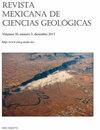墨西哥Michoacán-Guanajuato火山场Las Cabras火山:火山锥喷发的地形、气候和浅层岩浆控制
IF 0.5
4区 地球科学
Q4 GEOSCIENCES, MULTIDISCIPLINARY
Revista Mexicana De Ciencias Geologicas
Pub Date : 2021-07-21
DOI:10.22201/CGEO.20072902E.2021.2.1645
引用次数: 3
摘要
在地球上的大多数火山场中都有大量的火山锥,例如位于跨墨西哥火山带中西部的Michoacán-Guanajuato火山场。然而,尽管其形状和组成多样,其危险性广泛,但对其喷发方式和控制因素的深入研究却很少。本文介绍了位于Michoacán-Guanajuato火山场中心Zacapu湖盆西部的Las Cabras火山锥的形态、地层学、沉积学、岩石学和地球化学研究结果。该玄武质安山岩-安山岩火山形成于距今27 ~ 26年前,位于El Tule火山熔岩盾的陡坡上(bbb10º)。随着时间的推移,它的主要喷发方式从斯特龙堡式变成了喷涌式。最初的爆炸活动形成了一个170米高的火山灰锥,并在周围倾斜的地形上沉积了厚厚的火山灰沉降物。沉积物中的构造表明,早期易碎的细粒岩由于同喷发的大雨和下伏地面的倾斜性质而遭受了明显的侵蚀。根据火山爆发前的地形,这种侵蚀产生的火山泥流很可能到达了扎卡普湖。随着爆炸性的下降,熔岩首先从火山锥的底部向南和东南方向喷发,形成了一个厚厚的粘性裂片,填满了之前存在的东西向山谷。然后,气流方向向北和东北方向偏移,形成较薄的、粘性较低的叶状气流,由一条明渠从通风口输送。熔岩上覆盖着由凝集物和炸弹构成的小丘,这表明火山喷发以火山锥体东南部分的灾难性崩塌而结束,这可能是由岩浆侵入引起的,岩浆侵入破坏了火山锥体下坡部分的稳定。突然的侧翼断裂可能与后期的火山喷发有关,丘群可能被熔岩涌流冲走了。整个岩石的化学变化和晶体不平衡结构指向一个复杂的岩浆供给系统,包括不同岩浆批次之间的混合和混合。研究表明,在坡度明显(bbb10°)的地形上,火山渣锥的形成对火山渣锥稳定性和火山灰侵蚀的影响对火山喷发动力学和相关危害具有深远的影响。它还证明了同喷发雨对细粒麻黄的侵蚀作用,特别是当沉积在斜坡上时。最后,揭示了单一成因安山岩火山浅层管道系统中可能发生的复杂岩浆作用,这在大陆弧的内陆地区尤为重要。本文章由计算机程序翻译,如有差异,请以英文原文为准。
Las Cabras volcano, Michoacán-Guanajuato Volcanic Field, México: Topographic, climatic, and shallow magmatic controls on scoria cone eruptions
Scoria cones are abundant in most volcanic fields on Earth, such as the Michoacán-Guanajuato Volcanic Field, in the central-western sector of the Trans-Mexican Volcanic Belt. However, there are few in-depth studies on their eruptive style and controlling factors, despite of their diversity in shape and composition which implies a wide range of hazards. Here, we present results of morphologic, stratigraphic, sedimentary, petrographic, and geochemical studies of the prominent Las Cabras scoria cone located west of the Zacapu lacustrine basin in the center of the Michoacán-Guanajuato Volcanic Field. This basaltic andesitic to andesitic volcano formed between 27 and 26 kyrs BP on the steep slopes (>10º) of the lava shield of El Tule volcano. Over time, its dominant eruptive style changed from Strombolian to effusive. Initial explosive activity built a 170-m-high scoria cone and deposited thick tephra fallout on the surrounding sloping terrain. Structures in the deposits indicate that early friable fine-grained tephra underwent significant erosion due to syn-eruptive heavy rain coupled with the sloping nature of the underlying ground. This erosion generated lahars that very likely reached the Zacapu lake based on the pre-eruptive topography. As the explosivity dropped, lava was emitted from the base of the cone first to the S and SE, forming a thick, viscous lobe that filled a pre-existing E-W valley. The flow direction then deviated to the N and NE, to form thinner, less-viscous lobes fed from the vent by an open-channel. The lavas are covered by hummocks made of agglutinates and bombs that indicate that the eruption terminated by catastrophic collapse of the SE sector of the cone, possibly triggered by the intrusion of magma within the cone, which destabilized its downslope segment. The sudden flank failure was potentially associated with a late effusive event and the hummocks may have been carried away by the lava surge. Whole-rock chemical variations and crystal disequilibrium textures point toward a complex magma feeding system, involving mixing and mingling between different magma batches. This study shows that the formation of scoria cones on a terrain with a marked slope (>10°) has profound impacts on the eruption dynamics and related hazards due to its effect on cone stability and ash erosion. It also evidences the erosive effect of syn-eruptive rain on fine-grained tephra, especially when deposited on a slope. Finally, it reveals the complex magmatic processes that may occur in the shallow plumbing system of monogenetic andesitic volcanoes, which could be particularly important in inland areas of continental arcs.
求助全文
通过发布文献求助,成功后即可免费获取论文全文。
去求助
来源期刊

Revista Mexicana De Ciencias Geologicas
地学-地球科学综合
CiteScore
1.00
自引率
12.50%
发文量
0
审稿时长
6-12 weeks
期刊介绍:
Revista Mexicana de Ciencias Geológicas (RMCG) publishes original research papers on geological processes of broad interest, and particularly those dealing with regions of Latin America. The RMCG also publishes review papers on topics of current interest, and on the geology and tectonics of geological provinces of Latin America. Besides, it offers the opportunity for host editors to publish special thematic issues.
 求助内容:
求助内容: 应助结果提醒方式:
应助结果提醒方式:


